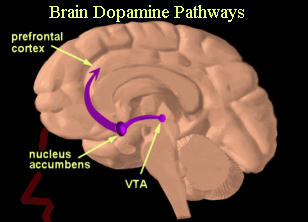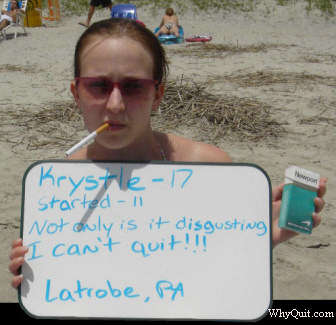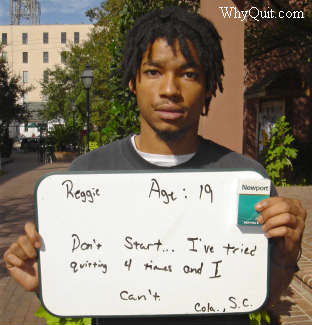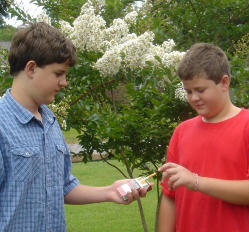
School smoking and nicotine dependency: students helping students
Is your high school plagued by high student tobacco use rates? Probably. But like an ostrich with its head stuck in the sand, most school administrators, principles and teachers simply pretend the problem isn't there. They fail to appreciate how nicotine is "the" gateway drug, a gateway that does not discriminate based on ethnic group but may in regard to attention deficits.
Educators seem not to grasp that once addicted to stealing brain dopamine it increases the likelihood the student will turn to other chemicals to engage in more intense and higher-risk dopamine robberies. Dependency driven risk-taking should be obvious when looking at the fact that 8% of all high school students say they smoked nicotine on school property within the past thirty days.
Most caught feeding their addiction are not treated and helped but suspended. Educators seemingly ignore evidence that nicotine dependency related suspensions create a sense of failure, diminished self esteem, put the student further behind in class-work, foster hopelessness and ultimately increase dropout rates.
When surveyed, 62% of high school smokers say they want to quit. Imagine at least 1 in 10 students in your high school being physically addicted to nicotine and the school having absolutely no program to help teach them how to reclaim control of their minds.
Not only is it a failure to educate the entire student but to address the most gripping health and education issue affecting their life. Sadly, it is rare when any educator has an understanding of nicotine dependency or the principles necessary to recover from it.
But why blame adults? What's stopping any student or student organization, including student council, from becoming the school's champion in helping educate the student body about both the horrors of becoming captive to a lifetime of nicotine addiction and how to break free?
Understanding Nicotine Addiction
A 2006 study found that 87% of students smoking nicotine at least once daily are already drug dependent under DSM IV mental health nicotine dependency standards. Whether the student's nicotine is delivered by cigarettes, cigars, smokeless tobacco, bidis, pipes, patches, gums or nicotine lozenges, understanding how they became hooked is key to understanding their path to freedom.
Brain dopamine pathways play key roles in addiction to nicotine, cocaine, alcohol, heroin and amphetamines. What is dopamine?
Do you remember the very first time you colored between the lines? Do you remember the wonderful "aaah" sensation you briefly felt? That was dopamine. The memory of it was burned into your brain and made you want to strive to do even better so you could experience the feeling again.
 The brain's dopamine pathways are a built-in teacher that uses reward related learning that ties goals to desire and action. It generates powerful memories that reinforce survival lessons and that ensure personal improvement. Pre-programmed, it tells us what we should pay attention to and what's important.
The brain's dopamine pathways are a built-in teacher that uses reward related learning that ties goals to desire and action. It generates powerful memories that reinforce survival lessons and that ensure personal improvement. Pre-programmed, it tells us what we should pay attention to and what's important.
The neuro-chemical dopamine flows when we anticipate or experience accomplishment, thirst or quench thirst, anticipate or eat food, or surrounding acts that unite us and keep us safe, such as nurturing, acceptance by friends, romance and reproduction.
What would it be like to live inside a mind that had no dopamine reward pathways? Imagine never feeling an "aaah" sensation when finishing a project, when seeing a good grade on your report card, upon making a wonderful new friend or getting a nice big hug from mom. Imagine no new "aaah" feeling or old "aaah" memories when the thought of eating food enters your mind. Without the "aaah" associated with hunger or thirst we might easily starve ourselves to death.
The dopamine pathways not only generate an "aaah" reward sensation surrounding species survival events but feed into and make a high definition memory recording in the prefrontal cortex of the brain, tying a particular "aaah" to the event that produced it. These associated memories become central to motivation, focus, craved stimulation and goals. It is what researches call "salient" memories, memories that force us to pay attention to important events, events that keep us alive, together, safe, achieving and multiplying.
But imagine what could happen if a chewed or smoked chemical entered our bloodstream, traveled up to our brain and by chance fit the locks (receptors) that allow dopamine to flow? What if a chemical from outside the body could arrive and override all natural programming and instantly cause a massive flood of unearned dopamine? What if the most powerful memories your mind was today producing had you focusing on the goal of again using an external drug - the super toxin nicotine?
Most smokers will tell you that their first cigarette tasted utterly horrible. But, within eight seconds of that first-ever inhaled puff, through dizzy, coughing and six shades of green, nicotine arrived at their brain's reward pathways where it generated an unearned flood of dopamine, resulting in an immediate yet possibly unrecognized "aaah" sensation.
It was then that they may have thought to themselves that they could not possibly ever get hooked because the taste was horrible and their body and lungs rebelled. Although they didn't like the taste it didn't matter whether or not they liked it because their brain had already recorded its first stolen "aaah" sensation and they would likely soon find themselves returning to steal more. As for the horrible taste, tobacco toxins quickly begin to deaden mouth and throat tissues making later cigarettes more tolerable.
But the brain senses and reacts to far too much dopamine flowing far longer than normal. It fights back by growing millions and millions of extra nicotinic receptors in at least eleven different brain regions, almost as if attempting to desensitize itself by more widely disbursing the arriving nicotine. It's what researchers call up-regulation.
But the new smoker soon detects that their current nicotine "aaah" sensation no longer matches the intensity of prior "aaah" memories. Now instead of smoking nicotine just once each day they start smoking it twice daily which overwhelms their brain's defenses and produces "aaah" memories that again match their expectation. But it's here, once desensitization begins that a new sense of normal is born as the brain is rewired to function with a specific level of nicotine present.
It's here that regular nicotine feedings become mandatory in order to maintain an evolving sense of "nicotine normal." It's here that any attempt to stop using nicotine may generate powerful anxieties, mini-panic attacks, craves and wild mood swings. It's here, when trying to quit, that so little natural dopamine is sensed that its absence convinces you that you simply can't quit using nicotine, that it's now part of who you are. It's here that failing, relapsing and smoking nicotine again seems vastly easier than enduring withdrawal. It's here that you convince yourself that the only way to make the craves stop is by putting more nicotine back into your bloodstream.
Each increase in daily nicotine intake may bring a corresponding increase in the number of brain receptors, further desensitizing the brain and moving it further away from normal function. Imagine this cycle of drug tolerance eventually requiring the new drug addict to smoke or chew nicotine 5, 10 or even 15 times a day in order to make the intensity of new nicotine use memories match those previously recorded.

What if friends, homework, mom and dreams suddenly became less important than the goal of finding and using more nicotine to steal more dopamine? What if powerful salient "aaah" memories of using nicotine started piling up and burying all memory of the "real" you deep beneath them? What if your mind's collection of nicotine "aaah" memories became so great that they clouded all memory of what life was like when your goals were associated with true companionship and accomplishment instead of planning and preparing for that next nicotine fix?
Yes, the new nicotine addict will likely make new friends but more often than not they'll find that their bond with them is built around the fact that they are both drug addicts, addicted to the exact same chemical. Imagine your most important circle of friends being those who will hopefully share their drugs with you or help you buy them, while fully understanding your body's intense need to use them.
Imagine a chemical becoming your new best friend. Imagine spending an ever increasing part of each day in planning and feeding your addiction. Imagine the lies you would be forced to tell about where you are going, where you had been, what you were doing, why you smell, where the money went or why you can no longer engage in prolonged vigorous physical activity without becoming winded. Imagine resorting to begging or stealing in order to feed your chemical addiction.
Welcome to the world of true drug addiction. The fact that nicotine produces an alert dopamine/adrenaline euphoria instead of drunkenness or delusions fools both students and society about just how extremely captivating nicotine is.
But addicted smokers are true drug addicts in every sense. Once established their addiction is as permanent as alcoholism. The only question becomes, on which side of the bars will they spend the balance of life? Will they ever successfully arrest their dependency or will it keep them arrested, enslaved and imprisoned for life?
If asked, 80% of smokers in your school will tell you that they can quit smoking nicotine if they wanted to. But reality does not match their beliefs as about half have already tried quitting within the past year and failed. If fact, only 5% believe they will still be smoking in 5 years when studies show that about 75% will still be hooked solid 7 years from now. They need help now but from whom when their principle and teachers pretend that the problem doesn't exist?
Nicotine - a Super Addictive Super Toxin
Nicotine is one of earth's most toxic chemicals. Drop for drop it is deadlier than diamondback rattlesnake venom, arsenic, strychnine or cyanide. But by chance, once inside the human brain, this natural insect killer is so similar in shape to the brain's acetylcholine molecule that it snugly fits acetylcholine receptors. Through these receptors, and cascading, nicotine is able to control the flow of more than 200 of the body's natural chemicals.
 Researchers contend that nicotine may be the most perfectly designed drug of addiction as it not only releases dopamine but allows released dopamine to remain in the chemical gap or cleft between brain cells (called the synapse) far longer than normal. MAO B is called the "killjoy" enzyme because its job is to clean-up excess dopamine remaining in the synapse. But nicotine somehow diminishes MAO B in the user's brain, allowing more dopamine to remain in the synapse longer than other drugs of addiction. It has been described as a "double whammy." The powerful nicotine "aaahhh" memories generated by this double whammy may actually make it harder to break free from nicotine than other drugs of addiction.
Researchers contend that nicotine may be the most perfectly designed drug of addiction as it not only releases dopamine but allows released dopamine to remain in the chemical gap or cleft between brain cells (called the synapse) far longer than normal. MAO B is called the "killjoy" enzyme because its job is to clean-up excess dopamine remaining in the synapse. But nicotine somehow diminishes MAO B in the user's brain, allowing more dopamine to remain in the synapse longer than other drugs of addiction. It has been described as a "double whammy." The powerful nicotine "aaahhh" memories generated by this double whammy may actually make it harder to break free from nicotine than other drugs of addiction.
For far too many students that first powerful puff, dip or chew of nicotine will be enough to keep them coming back for life. For others it may take using nicotine a few times over a period of days, weeks or possibly even months before a growing mountain of salient memories totally consume them, up-regulation begins, and they begin to believe that its use is as mandatory as eating food or drinking water.
Noticing the Onset of Chemical Addiction
What are the warning signs that nicotine use may have already deprived you of the freedom and autonomy to turn and effortlessly walk away? They include feeling that you "need" a cigarette, chew or dip, a strong urge or crave to smoke or use oral tobacco, finding it hard to concentrate, feeling more irritable, feeling nervous, restless or anxious because you couldn't smoke, dip or chew, finding it hard to keep from smoking or using oral nicotine products in places where you are not supposed to (like school), trying to quit but being unable, noticing that it's really hard to quit, or feeling addicted.
Urges and craves are often the earliest signs that powerful nicotine induced dopamine memories are changing your priorities in life. They can start after having used nicotine on just a few occasions. Among smokers claiming memory of how many cigarettes they smoked before noticing their first urge or crave command to smoke more (41% of all smokers claimed to remember), 29% claim that they experienced their first crave by the time they'd smoked their 3rd cigarette. Another 9% say it happened between the 4th and 6th time they smoked nicotine.
Among smokers who claim to remember how many times they smoked nicotine before noticing their first urge or crave (46% claimed to remember), 21% indicated that their first crave to smoke arrived within 2 days of starting to smoke, and another 16% report that it happened on the 3rd or 4th day after starting.
Nicotine Withdrawal and Recovery
One of the greatest challenges of withdrawal is developing the patience needed to allow the brain time to restore acetylcholine receptor counts back to normal (down-regulation). As mentioned, by imitating acetylcholine nicotine not only controlled the flow of dopamine but a host of other brain chemicals as well, including adrenaline and serotonin.
The brain's protective up-regulation adjustments insured that any attempt to stop using nicotine would leave the recovering nicotine addict temporarily de-sensitized. Their dopamine reward system will briefly offer-up few rewards, their nervous system might see altering the status quo as danger and sound an emotional anxiety alarm throughout the body, and de-sensitized mood circuitry might briefly make it difficult to climb beyond depression.
Physical withdrawal symptoms peak within three days and normally pass within two weeks. Symptoms can include anxiety, anger, hostility, rapidly cycling emotions, lashing out at the world around you, impatience, irritability, restlessness, sadness, depression, an inability to concentrate, serious time distortion, headaches, chest tightness, feeling tired or fatigued, over-eating, difficulty sleeping, coughing, bleeding gums, stomach pain, nausea, gas or constipation.
Helping Students Arrest Their Dependency Upon Nicotine
The most important lesson to learn is that once hooked on nicotine the brain somehow remains wired for nicotine for life. Students can arrest their dependency but they cannot kill it. Regardless of how long they quit they will always remain just one powerful puff, dip or chew of nicotine away from both reviving old nicotine-dopamine "aaah" memories and creating a new one.
The Law of Addiction - Key to lasting recovery is to treat nicotine dependency as a true chemical addiction instead of some "nasty little habit." In fact, treating any addiction like a habit is a recipe for relapse. Students need to see a bright line in the sand that says, "once I quit if I use any nicotine I will relapse back to my old level of nicotine use or greater." Successful recovery boils down to just one rule ... no nicotine just one day at a time, Never Take Another Puff, Dip or Chew!
 Two factors will substantially enhance a student's odds of success: (1) dependency education and (2) ongoing support. Few students are able to learn math or learn to read and write by figuring it out on our own. Having teachers really helps. Why would learning how to recover from drug addiction be any different?
Two factors will substantially enhance a student's odds of success: (1) dependency education and (2) ongoing support. Few students are able to learn math or learn to read and write by figuring it out on our own. Having teachers really helps. Why would learning how to recover from drug addiction be any different?
No student will ever be stronger than nicotine but they don't need to be as strength is not the issue. It's intelligence. You see, nicotine is just a chemical. It cannot think, plot, plan or conspire and is not some demon that dwells within. Nicotine's strength is overcome by putting our greatest weapon of all to work, our vastly superior intelligence. But how?
WhyQuit.com has assembled what is likely the Internet's largest collection of free nicotine dependency recovery materials. They can be printed and shared, counseling videos can be watched, and online support received all within your school. The collection includes:
- Motivational stories for smokers like Bryan's and Noni's
- Motivational stories for smokeless users like Sean's or Gruen's
- Quitting tips lists for smoking or vaping students and smokeless tobacco users
- Nearly 100 short quitting articles on almost every topic imaginable
- A free 149 page PDF quitting book entitled "Never Take Another Puff"
- More than Nearly 500 video quitting lessons that can be watched
- Free online group support
- An alphabetical index of group discussions on hundreds of quitting topics
It can take up 72 hours (3 days) to rid the body and mind of all nicotine. It is by then that withdrawal anxieties peak in intensity and begin to gradually subside. It takes about two weeks before the average quitter gets to a point where their addiction is no longer doing the talking and they can begin to get a realistic picture of what life without nicotine will be like. Although the most challenging part is behind them, they'll continue to wade through gradually diminishing thoughts of wanting to smoke or chew nicotine for a few months. During those months the recovering student would benefit greatly by having access to some form of regular ongoing peer to peer support.
It is here that a school's "Freedom from Nicotine" club or program could greatly benefit recovering students. Negative peer pressure likely played a significant factor in enslaving dependent students. Positive peer pressure in the form of a weekly in-school group peer-support program can be just as powerful a force in helping them break free and regain control of their mind and life.
Establishing serious and highly focused in-school nicotine cessation support programs and getting quality education materials into the hands and minds of smoking students will take dedicated leadership. But the biggest challenge isn't in creating a high quality school program but in finding creative ways to help dependent students see through their thick protective wall of dependency denial rationalizations so as to motivate them to participate in the program. It's a tremendous challenge but a challenge that can and must be met.
Youth Nicotine Dependency Prevention
How do we help students avoid getting hooked in the first place? Key is in being totally honest about the the power of nicotine. Listen to this key study finding again: 87% of students who smoke nicotine at least once daily are already chemically dependent under DSM IV standards. Students must begin to appreciate and accept the fact that nearly all students who have a need to ingest nicotine before, during or after school are already true drug addicts.
Until students understand that nicotine truly is one of the most captivating chemicals on earth they will not have the information necessary to make an informed decision about the risk of getting hooked by using it. Remote tobacco use risks such as mouth or lung cancer, heart attack, emphysema or stroke rarely happen without the risk of getting hooked happening first.
 Since the year 2000 Canadian youth smoking rates have taken a nose dive but they have been taught a critical lesson that U.S. students have not. Here in the U.S. there is no cigarette pack addiction warning label. In Canada one-half of the front face of random cigarette packs carry a warning which reads, "WARNING - CIGARETTES ARE HIGHLY ADDICTIVE - Studies have shown that tobacco can be harder to quit than heroin or cocaine."
Since the year 2000 Canadian youth smoking rates have taken a nose dive but they have been taught a critical lesson that U.S. students have not. Here in the U.S. there is no cigarette pack addiction warning label. In Canada one-half of the front face of random cigarette packs carry a warning which reads, "WARNING - CIGARETTES ARE HIGHLY ADDICTIVE - Studies have shown that tobacco can be harder to quit than heroin or cocaine."
There is absolutely nothing stopping any U.S. health organization, teacher or school from teaching U.S. students the truth about nicotine's power. Failure to put nicotine on a par with other drugs of addiction naturally leads students to believe - and sends a loud and clear message - that smoking or chewing nicotine is less risky than using other drugs. The message is false and each year needlessly costs hundreds of thousands of students their neuro-chemical freedom.
While illegal drug use presents a vastly greater risk of death than smoking during a student's high school years, when lifetime risks are considered there's no comparison. During 1998 a total of 16,926 Americans died from illegal drug use while during the same year 418,690 deaths were attributed to smoking nicotine, nearly 25 times as many deaths.
A mother whose teen is addicted to smoking nicotine has a 50/50 chance of correctly guessing her son or daughter's cause of death if unable to quit. Addiction to smoking nicotine today claims one in four smokers during middle-age, each an average of 22.5 years early. This statistic means that there is substantial likelihood that a non-smoking mother will eventually be forced to attend the funeral of her smoking child.
Friends Don't Hook Friends
 The greatest asset each school has in preventing nicotine addiction is its ex-smoking students, hooked students and those battling to break free. Instead of hiding their addiction, imagine inviting them to share their struggle . Imagine hall posters sharing their picture and message. Imagine an annual assembly program where a number of smoking and ex-smoking students are allowed to tell their peers the truth about how easy it is to get hooked, how un-cool it is to live life as nicotine's slave and what it's like trying to break free.
The greatest asset each school has in preventing nicotine addiction is its ex-smoking students, hooked students and those battling to break free. Instead of hiding their addiction, imagine inviting them to share their struggle . Imagine hall posters sharing their picture and message. Imagine an annual assembly program where a number of smoking and ex-smoking students are allowed to tell their peers the truth about how easy it is to get hooked, how un-cool it is to live life as nicotine's slave and what it's like trying to break free.
High schools permit the establishment of environmental, hobby and religious clubs. In that nearly 90% of new smokers are under age twenty, administrators would be wise to encourage and foster the creation of a student organization dedicated to school and community nicotine dependency prevention. Not only could they serve as a non-threatening communication link with students who are hooked and in need of help, they can serve as a front-line force to keep the nicotine addiction industry out of schools.
Go to the school library and look at the cigarette ads in the back of any Popular Science or Popular Mechanics magazine. In that the magazine cover mailing label is to a high school and selective binding has long allowed magazines to remove or replace ads going to any destination they want, do you really believe the ads are in your school by chance? In fact, sadly, our nation's Attorneys General implicitly agreed to allow the tobacco industry to continue marketing tobacco inside America's schools.
As with any school environmental club, a dependency prevention club could and should be encouraged to become active within the community. How close to middle and high schools are nicotine products currently being sold? Is it really necessary for locations selling nicotine to have large exterior signs bombarding passing children and teens with creative invitations to smoke? Should students remain silent while convenience stores hang tobacco marketing signs above candy racks? Do weekly grocery store newspaper inserts bring cigarette advertising to student breakfast tables? Why?
Imagine the collective power of young yet determined voices to change the way an entire community looks at both nicotine dependency and marketing that fuels it. If almost all adult smokers are hooked solid (about 90%), is it honest for store tobacco signs to teach youth that a particular brand is smoked for flavor or taste? For that matter, if smokers smoke for taste then why do they suck the smoke deep into their lungs and briefly hold it, when there are zero taste buds inside human lungs?
The neighborhood candy, soda and chips store has become nicotine addiction central. Isn't it time for students to be taught to see through the false image painted by nearly $15 billion dollars in annual tobacco marketing? If adults refuse to fight to protect them, isn't it time we granted students some degree of control over how many of their friends and classmates become nicotine's slaves?


